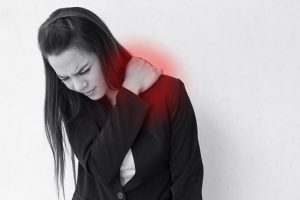 While not as common as lower back pain, upper back pain still plagues many people on a daily basis. The upper left back is the region to the left, below the neck (cervical spine), and above the lower back (lumbar spine). The upper back is often referred to as the thoracic spine and is generally considered the most stable part of the spine. The motion of the upper back is mostly restricted due to the spines attachment to the rib cage.
While not as common as lower back pain, upper back pain still plagues many people on a daily basis. The upper left back is the region to the left, below the neck (cervical spine), and above the lower back (lumbar spine). The upper back is often referred to as the thoracic spine and is generally considered the most stable part of the spine. The motion of the upper back is mostly restricted due to the spines attachment to the rib cage.
Left upper back pain can be the result of various causes, with pain in the muscles (musculoskeletal) being the most commonly reported cause. Pain is often felt suddenly and sharply. It can be experienced over a generalized area or possibly focused on a specific point. Pain in the upper left of the back can be acute in nature (occurring suddenly) or chronic (occurring for long periods of time).
Potential causes of upper left back pain
Injuries
- Fractured ribs, bones, or damage to a spinal vertebra
- Damage or tears to muscles and ligaments
- Back injuries during sports
- Cuts, wounds, or abrasions on the back
Musculoskeletal pain
- Poor posture can lead to upper back pain over time.
- Quick improper body movements, like when twisting or lifting, can pull and strain the back muscles.
- Disorders of the spine including intravertebral disc protrusion, damage to the disc, compression of spinal nerves.
- Fibromyalgia: a disorder characterized by widespread musculoskeletal pain, myofascial pain, and other muscle pain related conditions that can affect the upper back muscles.
- Conditions affecting the joints of the ribs and shoulder joints such as osteoarthritis and sometimes rheumatoid arthritis. Spinal columns may also be affected by these conditions.
Nerve conditions
- Spinal issues leading to pinched nerves can cause tensed muscles in the upper back
- A stroke can leave sufferers with chronic pain, numbness, and weakness
- Infections such as shingles can affect nerve distribution regions that extend to the upper back, leading to pain.
Other possible causes include:
- Osteomyelitis (infection or inflammation of the spinal bones)
- Osteoporosis (metabolic bone disease)
- Paget’s disease of the bone
- Spinal degeneration (degenerative disc disease, also called spondylosis)
- Spinal stenosis (a narrowing of the spinal canal that presses on the spinal cord or nerves)
- Spine fracture
- Spondylitis (infection or inflammation of the spinal joints)
- Heart attack
- Kidney stones and disease (although this pain is usually below the rib cage)
- Multiple myeloma
- Spinal tumor or cancer (the tumor can be noncancerous, also known as benign)
Upper left back pain symptoms
Advertisement
Symptoms will often depend on the cause of left upper back pain, with some similarities being common among all cases due to its location. Acute and chronic conditions may both present with different symptoms depending on the time of onset. The following are some of the symptoms you may experience with a diagnosis of left upper back pain.
- Pain
- Tightness
- Stiffness
- Muscle spasm
- Tenderness to touch
- Headache
Other possible associated symptoms include:
- Anxiety
- Depression
- Fatigue
- Fever
- Headache
- Morning back stiffness
- Neck pain
- Redness, warmth, or swelling
- Shoulder pain
- Sleep disturbance
- Stress
Upper left back pain treatment tips
It is always a good idea when performing sports or any activity that can lead to bodily harm to wear protective equipment. The best form of treatment is the prevention of the injury in the first place. Stretching on a regular basis, sleeping on a semi-hard mattress, and investing in office chairs with adequate back support are great ways to prevent this injury.
Treatment in of upper left back pain will depend on the underlying cause. Acute injuries, fractures, and ligament strains may be treated with the RICE formula: rest, ice, compression, and elevation. Hot or cold compresses may also be used.
Related: How to use essential oils for back pain relief
